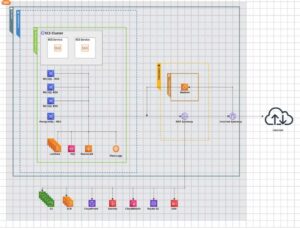Executive Summary
To migrate a cloud infrastructure supporting AI-driven translation technology data models from Microsoft Azure to Amazon Web Services (AWS) and transfer 150 million database files, Sanas turned to Avahi Technologies. Avahi designed and implemented an application architecture with compute resources that provide improved scalability, reliability, and security for the data model training workloads. Avahi also completed the migration in one week—50% faster than anticipated.
Thanks to the Avahi architecture design, data model training runs efficiently in AWS, and the environment can scale quickly as the workload demand increases. Even more importantly, with Sanas leveraging the environment to train and deliver effective data models to user devices, customers enjoy great experiences each time they interact with the translation technology.
About the Customer
Sanas is breaking collaboration barriers—one conversation at a time—with the power of effortless, real-time accent translation. The technology revolutionizes discussions by giving multilingual speakers a choice when it comes to how they communicate. Sanas solutions empower individuals, advance equality, and deepen empathy to help the company achieve its mission of making lives better by expanding the horizons of what is possible with each person’s voice.
Customer Challenge: Improve Data Modeling Infrastructure Scalability and Reliability
As a startup company, Sanas had previously designed and deployed the infrastructure to support its translation data models on various cloud platforms to test which service would work best and operate cost-efficiently. These included Amazon Web Services (AWS), Microsoft Azure, and the Google Cloud Platform. As customer activity picked up, the leadership team realized the machine learning models that enable translation services to work properly on customer devices required a high level of compute firepower—particularly for server GPUs (graphics processing units).
“We need to make sure our schedules for training the data models stay on time,” says Shawn Zhang, the CTO for Sanas. “This allows us to refine the models faster to improve the translation services we deploy on customer devices.”
In addition to improving the scalability of compute resources, Sanas wanted to increase the reliability of its cloud environment so that data modeling training would never be interrupted. Another key requirement was security. Where customers use the service to record their voices, the leadership team wanted to make sure that voice files could never be tampered with by someone else.
Sensing that a migration from Microsoft Azure to a new environment would be necessary to meet the scalability, reliability, and security requirements, the Sanas leadership team knew a big challenge would be the size of the data stores connected to its Microsoft SQL and PostgreSQL databases. The data stores contained 150 million files—moving them quickly would be paramount to avoid disrupting data model training.
Partner Solution: Avahi Provides Required Cloud Architecture and Migration Expertise
The solve these challenges, Sanas identified Amazon Web Services (AWS) as the ideal environment for its cloud infrastructure. “We chose AWS to ensure we would not face any limitations in scaling our compute resources as we spun up virtual machines,” Zhang says. “We also wanted to eliminate any problems in terms of resource availability, and we knew AWS could deliver on these requirements. They also offer strong support in terms of technical knowledge and provide the ability to connect directly with their team—they are always responsive.”
AWS recommended that Sanas leverage the AWS Migration Acceleration Program (MAP), which is based on migrating thousands of customers to the cloud. MAP streamlines cloud migrations with an outcome-driven methodology that reduces costs and automates the migration process.
As part of the MAP program, AWS advises customers to work with an AWS partner and in this instance, AWS referred Sanas to Avahi Technologies, which specializes in deploying AWS solutions for startup firms. Avahi provided Sanas with cloud experts to help with the design of the AWS environment and the migration from Microsoft Azure.
“Partnering with Avahi was key because we did not want to divert our software developers from their primary responsibilities,” Zhang points out. “We were also impressed with the AWS knowledge of their solution architects—they’ve handled many AWS designs and migrations. The Avahi senior management
team also met with us face-to-face. All these factors gave us confidence Avahi could complete the migration quickly so we could conduct all of our training model testing in one cloud environment.”
Using Terraform, Avahi created an infrastructure-as-code architecture. Avahi also designed an Amazon Elastic Container Service (ECS) cluster to host the SQL and PostgreSQL databases that communicate data model information to customer devices through Amazon Simple Queue Service (SQS) messaging and an internet gateway attached to a bastion server, which provides secure access to a private network, as shown in the image below:

The ECS cluster orchestrates application containers to simplify deployments and scaling, and the cluster integrates with AWS Lambda—a serverless computing platform—that runs software code and automatically manages required compute resources. Another key component of the architecture is AWS Elastic Beanstalk, which orchestrates file saving to Amazon Simple Storage Service (S3).
For additional security, Avahi configured security groups, network access layers, user roles, and AWS Secrets Manager to manage credentials when users store files. Other key security services include AWS Identity and Access Management (IAM) and Amazon Route 53, which provides a domain name system.
Results and Benefits: Reduced File Transfer Time and Streamlined Data Model Training
To improve the reliability of interactions between the translation services and the data models, Avahi implemented an Amazon CloudFront content delivery network across multiple availability zones. Avahi also deployed Amazon CloudWatch to allow Sanas to monitor compute resource and application performance, and if necessary, reroute users to a different availability zone.
To streamline the migration of the 150 million files along with the database schemas and data to AWS S3 block storage, Avahi first conducted a pilot test of a few million files, using AWS DataSync. The test confirmed it was best to migrate smaller subsets of the files (at the folder level) to accelerate the process. Avahi then set up four agents that ran concurrently to handle different web services and completed the migration within one week. This reduced the migration time by 50% compared to what Sanas was expecting.
“The migration went very smoothly,” Zhang says. “Once we verified the training model was working properly in AWS, we shut down our previous cloud environment and started conducting all the model training in AWS. Avahi was also helpful with tasks that fell outside the scope of the project, such as
organizing the data model code base.”
In addition to a reliable infrastructure that can quickly scale virtual machine resources to support the training models, the AWS infrastructure designed by Avahi has helped Sanas refactor its data pipelines in terms of how effectively the database tools collect, filter, process, validate, and store data. With the infrastructure now deployed in the AWS cloud platform, the GPUs fully meet the machine learning requirements of the translation technology—thanks to the advanced processors AWS provides.
Sanas also achieved its security objectives. Most importantly, with data model training running efficiently, Sanas customers can trust a great experience each time they interact with the translation technology. “We also benefitted from how quickly Avahi completed this project,” Zhang adds. “This allowed us to connect the data modeling environment to a new machine learning ops platform that we were building in AWS to automate production workflows and to track our model training and model deliveries. This system can help us expand our markets and requires customer data processed by the data modeling
architecture.”
Looking back at the engagement with Avahi, Zhang appreciates that he felt comfortable with Avahi right out of the gate, particularly with the strong recommendation from AWS. This allowed Zhang and his team to avoid spending time vetting other potential partners. “Just like AWS, Avahi is very supportive and always responds quickly—it’s helpful to work with two partners that are in sync,” says Zhang. “Avahi moves fast, they are enjoyable to work with, and they have strong communication skills. They bring in strong technical teams and eliminate the headache of trying to hire and train resources we might only need for a short time period—Avahi is a great partner to work with.”
About the Partner: Avahi Technologies
Avahi Technologies is a cloud-native focused company and Amazon Web Services (AWS) partners with a team of cloud, data, and software engineering experts and experiences obtained through years of working within the cloud ecosystem. An extraordinary team of highly-certified Avahi experts excels in architecting and operating secure, automated, cloud-based solutions built on AWS. With a focus on becoming an extension to existing customer teams, Avahi offers exceptional service and works tirelessly to build the right solutions to solve business problems.




